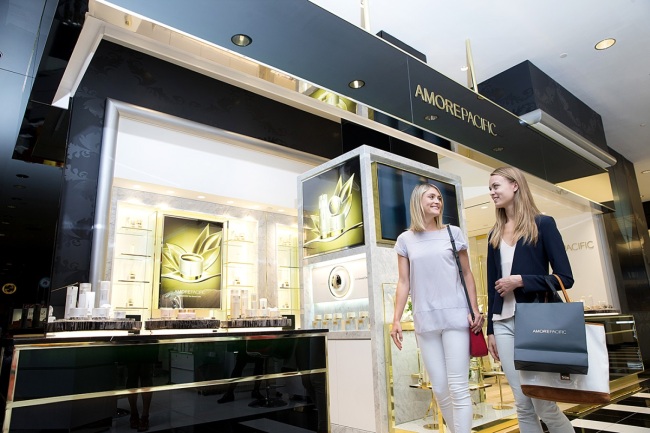Before Bailey Ewing leaves her home each morning, she lathers her face in eight different skin care products: cleanser, four different toners, serum, emulsion and sunscreen. The 35 minutes it takes her to complete her morning skin care routine and makeup is only a fraction of her two-hour evening routine -- something, she says, she learned only after arriving in Korea in 2014.
 |
Bailey Ewing wears a Korean-style sheet mask. (Bailey Ewing) |
“I never even had a skin care routine back home, and when you live in Korea you’re really bombarded with skin care and beauty, and the products are so accessible,” the 25-year-old from North Carolina said. Overwhelmed by choice, she began researching the products online and found a plethora of articles from US magazines and blogs detailing the products. “Just seeing the hype in the US for Korean beauty products and that it was so accessible to me, that’s what really piqued my interest,” she said.
While Ewing’s more than two-hour daily routine may sound excessive to some, she is one of the growing number of Westerners indulging in the Korean skin care routine.
Over the past five years, exports of Korean cosmetics to the US have increased more than fivefold, making it the third-largest importer of Korean-made cosmetics in 2016. The aptly dubbed “K-beauty” trend has been featured in Vogue and Elle magazines in the US and a huge number of blogs and forums have dedicated themselves to discussing and dissecting everything from Korean skin care products to how to find your own routine.
While K-beauty can offer quirky treatments wrapped in cute packaging, it’s the ingredients that keep US customers interested. Charlotte Cho, co-founder of Soko Glam, a New York-based company that acts as a gateway for US consumers to purchase K-beauty products, says that K-beauty is no passing fad. “Snail mucin, fermented yeast and yuza are unique ingredients that you wouldn’t typically find in products sold in the US. We have realized that when we introduce new ingredients to the market, it’s actually not a trend that reaches a peak and dies down,” Cho said.
This, coupled with the range of products and the affordable prices, has helped win over beauty consumers in the US.
Since the success of BB cream in the US in 2011, American companies have looked to Korea for innovative cosmetic products. Amorepacific, Korea’s largest cosmetics company, is home to one of the world’s biggest cosmetics research and development centers. The cosmetics giant is famous for its compact cushion technology, which spawned imitations from L’Oreal, and its products are available throughout top US department stores. Currently, Amorepacific sits at No. 21 on Forbes’ list of “The World’s Most Innovative Companies.”
 |
An Amorepacific store in Bloomingdale’s New York (Amorepacific) |
While the innovative and experimental nature of these products has yielded results with consumers, Cho says that Korea’s “skin-first” approach has sparked ample curiosity among US consumers.
“With consistencies in Korean lotions being lighter, the Korean skin care routine consists of using multiple products for a layering technique,” Cho notes. This “layering technique” is also known as the “10-step” routine, which is at odds with the minimal number of products generally used in the US.
The different philosophy is one of the keys to the success of K-beauty. Madda, from No Excuses Just Travel, suffered from milia -- small white cysts -- prior to coming to Korea from Wisconsin in 2014. After experimenting with a variety of Korean products, the 27-year-old found what worked for her and credits the products, as well as this different approach to skin care, with helping to clear up her skin problems.
“In the US, when I was younger, I felt that skin care was always approached as, you have skin that’s fine or you have acne and this is how you treat acne. And everyone was pushed in the same direction. Whereas here in Korea there’s more opportunity to customize things,” she said.
Beauty enthusiasts throughout the US tout the Korean skin-first philosophy as offering something new to US beauty consumers.
Coco Park, the US blogger behind The Beauty Wolf and co-author of “Korean Beauty Secrets,” believes this philosophy has the advantage of targeting skin concerns with specific products.
“The Korean approach is definitely more holistic and seeks to address skin care concerns with individual products targeting your needs, which is how you end up with a 10-step routine,” she said. “Korean wisdom says to make your face a flawless canvas for minimal makeup, whereas I feel Western standards pay little attention to skin care and focus more on covering blemishes with more makeup.”
While the 10-step routine may sound too time consuming for some, both Cho and Park believe the Korean routine is more about taking the time to find the right products and routine suiting you.
After some trial and error, Ewing found products that work with her skin on a day-to-day basis and credits it with keeping her complexion clear. But more importantly, her nightly two-hour self-indulgent K-beauty routine is a way to unwind after a long day of work.
“It’s so relaxing. I feel like I’m just indulging in a spa routine every night,” she said.
By Anita McKay (
anita@heraldcorp.com)">
anita@heraldcorp.com)









